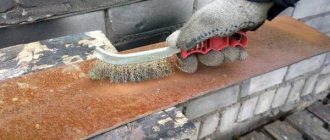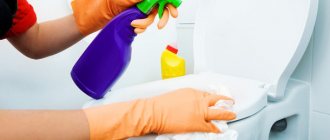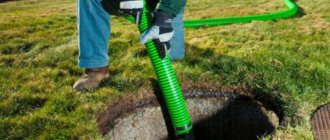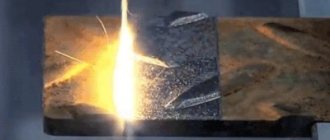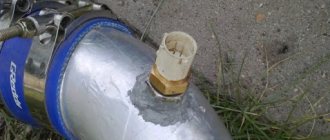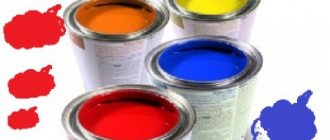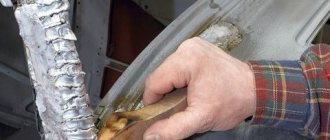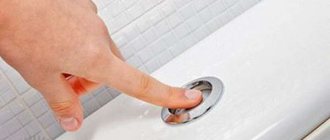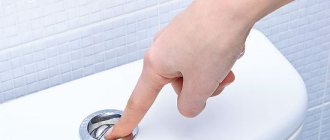Electrolysis removal of rust
Hi all. Many people have heard about the electrolysis method of cleaning rusted parts. But, probably, there are also those who have little idea about this extremely useful action, which easily replaces brushing and sandblasting. Here we have a very rusty, but smooth disk. Of course, it was possible to work on it with a grinder and a brush for an hour and a half, but I went the route for the lazier ones - the electrolysis method.
To do this you need: 1. A container for the solution - I purchased a large rubber basin (in principle, any dielectric material will do)
2. A substance, an aqueous solution that will be an electrolyte - preferably soda, baking soda or ash, it does not cause chemical burns (such as alkalis) and is easy to wash, does not contribute to further corrosion (such as table salt, chloride ions, which are then difficult to classify =»aligncenter» width=»340″ height=»344″[/img]3. Water. Ordinary water supply.
4. DC current source. It is best within 12-24 volts and with current regulation and indication. A charger or power supply from a computer will do.
I use an old 20 A battery charger with current and voltage display and step adjustment.
5. Positive electrode-anode. The best material for it would be stainless steel. If you don’t have stainless steel, then you can take chernukha as a last resort. But an ordinary steel electrode will quickly dissolve.
Pour water into the vessel. Making a solution. It’s difficult to say how much soda is used per liter of water. This depends on the shape of the part, the distance between the electrodes, and the voltage. I navigate by current. The basin I took took about 600 g of soda ash. We attach the “-” from the source to the part (it will be our cathode). There are a lot of ways. You can use a clamp (the paint can peel off from the clamp), or you can use a bolt like I did.
The main thing is to have good contact. We lower the part into the solution.
We attach the “+” from the source to the anode. The anode, as I already wrote, is best made of stainless steel. Ordinary steel will dissolve, but if you don’t have an old unnecessary spoon/fork or a trough from an old washing machine on hand, then chernukha will do just fine. However, I noticed that if you use ordinary steel for the anode, a dark coating settles on the workpiece, which then needs to be washed off.
Ideally, the shape of the anode should be such as to cover the entire area of the workpiece, otherwise the process will not proceed evenly from different sides and the workpiece will have to be turned over. In practice, it is difficult to make such an electrode, especially if we are cleaning a large-sized product, so you will still have to twist the part. Personally, in this case I made electrodes from chernukha, since I couldn’t find stainless steel at that moment. Here is the shape of the electrode for cleaning the front side of the disk:
For reverse:
We lower the anode into the solution. ATTENTION! The anode and the workpiece must not touch; there must be a gap of solution or dielectric.
We turn on our current source. Everything begins to bubble in the basin - the process begins. If there are indicators, then look at them. The speed of cleaning depends on the strength of the current that flows through the electrodes. And it, in turn, depends on the power of the source.
You can regulate the current in 3 ways: 1. By the source itself (if, of course, there is a possibility of adjustment on it) 2. By the concentration of soda - more soda in the solution, more current. 3. The distance between the anode and the product we are cleaning. The closer they are, the greater the current.
What maximum current to set here depends on your source. You can use at least 100A, but it’s better without fanaticism, it’s better to wait an hour or two than to burn the device, especially if it doesn’t have overload and overheating protection. Personally, I put 10-15 A.
It is also necessary to take into account that with a high current the solution heats up (it turns out to be a salt heater). This is what the solution looks like after an hour of cleaning, the borscht is excellent)))
After several hours of cleaning, we take out the part and use a metal brush under running water to clean off the loose rust and look at the result. If rust is still present, leave it for another couple of hours.
Here's the result:
Front side
Interior There is no rust at all. Here is an example of cleaning the brake caliper of a VAZ 2108
After
ATTENTION! The gases released during electrolysis are hydrogen and oxygen. Their mixture is called explosive gas, although it is not at all poisonous, it is very EXPLOSIVE! Therefore, work should be carried out in a very well-ventilated area, or in the fresh air!
Author; Vladimir Bezdukh Ternopil, Ukraine
Cleaning coins and other finds with electrolysis
Hello everyone! Metal detectors come across many different objects made of copper, iron, silver and bronze. And some finds need cleaning. Of course, there are gentle methods, for example, soaking coins in soap, mechanical cleaning, or even boiling in soda. However, there are such advanced cases when the layer of dirt and oxides cannot be overcome by such methods. For example, a coin has been in a fire and neither the denomination nor the year of minting is visible under the hard crust. Or you want to clean rust from a small iron object. Then I can suggest electrolysis as an alternative and quick method.
In general, from the point of view of science, electrolysis is the process of separating the constituent parts of substances on electrodes when an electric current flows through an electrolyte solution. I have heard more than once that it is also called hydrolysis. It is not right. In addition, electrolysis is used in the electroplating of metals with copper or gold. This principle is also used in electroplating - repeating the shape of objects.
And so, before starting the main part of the article, I warn you that you should not clean good real coins, buttons, crosses and other finds with electrolysis. Especially those that cost money and have high historical value. Electrolysis removes the patina and opens cavities. And if the relief of the coin consists entirely of loose oxides, after such cleaning you will end up with a bald round piece!
For electrolysis cleaning, we first need a container into which our electrolyte solution will be poured. Next you need a 9-12 volt power supply. Of course, you can use 5 volts, but the cleaning speed will be lower. To secure coins and finds, it is better to take crocodiles or some kind of improvised clips. By the way, a winding ring from keys and key fobs is suitable for coins. It is better to take a small metal plate as an electrode. To prepare a conductive solution, you can take salt or soda. Salt has one disadvantage - during the reaction, chlorine bubbles are released, which is a dangerous gas. By the way, in the First World War it was used for chemical attacks. So, soda would be safer.
Prepare an electrolyte solution. Pour clean water, preferably distilled, into a glass or plastic container. Put a couple of tablespoons of soda or salt in there and stir. This stage is ready. Now you need to connect the item that needs cleaning and the metal plate. Here we have two options:
- The positive wire clings to the find, and the negative wire to the plate. This way, cleaning will go faster, but there is a risk of overlooking and completely ruining the coin.
- The plus is connected to the plate, and the minus to the find. In this case, the reaction will begin to proceed more slowly and it will become easier to control the cleaning process. Bubbles will actively rise from the object thrown into the solution.
People who often clean something with electrolysis have special jars with contacts and electrodes. I do this process quite rarely and when I need to clean an item, I just take the power supply, clamp, plate and dishes. I connect all this, clean it, and then the whole thing is disassembled again and used for its intended purpose.
This whole thing is connected, the solution begins to bubble and become cloudy. This means everything is fine and cleaning is proceeding as normal. From time to time, remove the object dipped into the electrolyte and check its degree of cleanliness. Also keep an eye on the process so that a short circuit does not occur.
Intermediate result
In this case, I connected a weight found in an abandoned village by simply wrapping the wire around the handle. Simply because the crocodile was not found at home. She soaked in vinegar for a couple of days, but to speed up the process, I decided to use electrolysis, and at the same time write an article about it for the website. In total, it took an hour to clean this find.
Advantages, disadvantages and step-by-step instructions for removing rust by electrolysis
Dealing with rust and not damaging the metal surface is not an easy task.
The mechanical method of removing it leads to scratches on the product, and chemical reagents provoke oxidation processes, as a result of which the part will rust even more in the future.
A safe and relatively simple way to combat rust is to remove it by electrolysis. Read the article to learn how effective this method is and how to implement it correctly in practice.
Is the method effective?
Electrolysis really helps with rust. It is a mixture of iron oxides and hydroxides, which are formed when the metal comes into contact with water and oxygen.
Electrolysis is a chemical reaction that reduces iron from its oxide to its metallic form. Wherever the electrolyte penetrates, the process of rust decomposition begins.
Without delving into complex chemical processes, we can say that the method allows you to reverse the oxidative reaction and restore previously damaged areas .
Correctly, this method of fighting rust is not called electrolysis, but the electrogalvanic method. It is used not only in everyday life, for personal needs, but also for a more serious purpose, for example, in the restoration of archaeological finds.
Pros and cons of cleaning
Electrolysis, as a method of combating rust, is absolutely safe.
The electrolyte solution is not poisonous, but should not be ingested. The gases released are non-toxic and non-flammable . The currents used are of low frequency, so they cannot cause harm to health.
Another advantage of the method is that there is no risk of damaging the part. Even if you keep it in the solution, nothing bad will happen; the self-healing process will not reverse because of this.
In comparison with mechanical and chemical methods of rust removal, electrolysis has one very important advantage. This method does not affect “living metal” , that is, one that has not yet undergone changes.
Abrasives, brushes, acids and other aggressive methods inevitably lead to the fact that some part of the undamaged metal will be removed, but this does not happen during electrolysis.
In addition, you will have to spend some time not only on preparatory measures, but also on the cleaning itself.
Rules for removing plaque at home
To remove rust from a metal surface by electrolysis, you will need:
a suitable plastic container, such as a bucket or basin;- a steel or stainless steel plate that will act as an electrode - it is better to give preference to stainless steel, since it will last much longer than ordinary metal; it is good if the plate completely surrounds the perimeter of the part being cleaned;
- ordinary tap water;
- soda ash - it is sold in household chemicals departments; housewives use it to wash things;
- battery charger.
To prepare the solution you will need 3 water and 1 teaspoon of soda. The procedure is as follows:
- The prepared solution is poured into the container.
- An electrode is lowered into it.
- Immerse the part that needs cleaning into the solution. This is done in such a way that it does not touch the electrode.
- Connect the power. Polarity must be strictly observed. The electrode must be connected to the positive “+” conductor, and the object to be cleaned to the negative “-”. Contact with parts must be good.
- After completing all preparatory manipulations, turn on the power. If the charger is equipped with an ammeter, you can see how the system begins to pass current.
- After a short time, bubbles will appear on the part. This is completely normal and indicates that the cleaning process has started.
- The duration of the procedure depends on a number of factors. The size of the part and the electrode, as well as the area of rust, matters. Periodically, the system must be turned off, the product removed from the solution and inspected. The average duration of cleaning is 5-6 hours. If the object is covered with a very thick layer of plaque, you can leave it to soak overnight.
- When the cleaning process is completed, the part is removed, washed under running water and inspected. If there are small areas of rust left on the product, they can be cleaned off with a plastic scraper.
Electrolysis cleaning.
We all worry about how to clean iron. And we all do it in our own way. For example, I settled on electrolysis and I think that there is simply no better way. I am sharing with you my method for cleaning iron. Maybe it will be useful to someone. Making a cleaning device takes just a few minutes and is very affordable! I bought myself a universal power supply. I attached two wires to one of the adapters, inserted one inside and, to ensure reliable contact and fall out, inserted a simple match there. I simply wound a wire around the external contact and insulated it. It would be ideal, of course, to solder it, but I’m afraid that the plastic that insulates + and – might melt inside. I put crocodiles on the ends of the wires, it’s up to you to decide which ones you like. The result is a ready-to-use device. Next I give an example of cleaning that I found on the Internet. Of course, I could write it myself, but I’m afraid I won’t be able to write it more clearly than here. How to use it? Elementary! One of the simplest and most accessible methods in a home workshop is described below.
What are the advantages of this method? The advantage over mechanical methods is one, but important! This method does not affect living metal. When you clean with wire brushes, abrasives or acids, some metal is inevitably lost
The electrolytic method removes only rust. What about rusty bolts and studs? Sometimes the method helps in these cases. Wherever the electrolyte penetrates, the process of rust decomposition begins. It is safe? Absolutely! The solution is not toxic (although you should not drink it), the voltages are low, and no toxic or flammable gases are released. The process is self-stopping; overexposure of the workpiece does not pose any danger. What do you need to get started? Plastic bucket, stainless steel or steel electrode (plate), water, washing (soda ash). A teaspoon of soda dissolves in 3 liters of water. How long can the solution be used? A teaspoon for 3 liters? It's easier to pour it out and make a new one. But if you really need it, just add water to 3 liters and continue. What can you say about the electrode? Ideally, the electrode should completely surround the object being cleaned, then the process is very active. It all depends on your capacity. A flat plate will also work. The steel electrode will become thinner over time and will have to be replaced with a new one. A stainless steel electrode lasts much longer. How to connect the charger? Polarity is critical. The electrode must be connected to the positive conductor, indicated by the + symbol. The object being cleaned is a minus. Try to ensure the best possible contact with the object being cleaned. How will I understand that everything worked? Place the electrode in the vessel with the solution. Position the part to be cleaned so that it does not touch or touch the electrode. Turn on the power. If there is an ammeter on the charger, you will see that current is flowing through the system. After some time, bubbles will appear from the surface of the workpiece. How long does the process take? The time depends on the size of the part, the size of the electrode and the amount of corrosion. Remove the part from the solution and inspect it. I take a metal brush and clean the surface under running water. If you are not cleared, continue. Typically, the cleaning process for medium-rusty parts takes 5-6 hours. Very rusty parts can be left overnight. What then to do with the cleaned part? Rinse under running water. Dry the part with a heat gun or place it in the sun. Cover with a thin layer of lubricant. The part is very healthy, can it be cleaned in parts? Yes. What does the part look like after processing? The surface that was corroded will be black; the pitting will not disappear. Pure metal will remain pure. What to do with electrolyte after work? Pour it down the drain. This is not dangerous. Can I use metal containers? Dangerous. Either it will shorten or holes will appear. Better than plastic. What containers can be used? Any you find. Long pieces of iron can be put into a plastic pipe, wide and flat ones - into a trough (but put a film on the bottom so that there is no short circuit. Good luck
Helpful information
To ensure that the process of removing rust from metal by electrolysis is as successful as possible, you need to take into account the following tips:
The part should only be processed in a plastic container. Metal buckets or basins are not suitable for this purpose. Their use carries the risk of short circuits or holes.- If there is pitting corrosion on the product, you should not try to remove it by electrolysis. The electrolyte is not able to penetrate the thickness of the metal.
- Once processing is complete, no special disposal measures need to be taken. The solution is simply poured into the sewer; this will not cause any harm to the environment.
Removing rust stains using an electro-chemical method.
There is an excellent chemical method that really removes rust from a car, and I don’t understand why rarely anyone uses it, because it’s cheap and simple.
It's no secret that a car's body begins to bloom over time. For internal work, it is enough to pour some kind of mud into the cavities and periodically update them, but on the front side it is not so easy.
There is an effective method - electrochemical, i.e. electroplating Under the influence of current and chemistry, rust is completely removed from the metal without disturbing the surface of the pure metal. And again, under the influence of current and chemistry, it is possible to coat already pure metal with zinc, thereby preventing this place from blooming further.
What's good about this method:
1. Budget. The components are much cheaper. 2 . Time. It takes 10 minutes to remove and protect a specific surface. 3. No need to paint, pay money.
I got tired of looking at the saffron milk caps after every wash and decided to get rid of them. Cheap, radical, cheerful. The components were found by trial and error.
What you will need: Soda ash, soldering acid, stainless steel and zinc.
1. Removing rust. Ingredients and where to get them: Soda ash. It costs a penny. Stainless steel. Either from stocks, or buy, selling all sorts of goodies for welding. In my case, this is a stainless steel twig for a semi-automatic machine.
2 . Galvanization. Components and where to get them: Zinc. Need a clean one. Available in salted batteries. The body is made of pure zinc. You can check it with a magnet. What we need is not magnetic. Soldering or orthophosphoric acid.
Well, what will we do with it: a charger, or a battery,
cotton pads, or a cloth, tape for fixation.
And most importantly, after all the procedures, the treated iron must be treated with a soda solution. Roughly half a liter of water, 4 teaspoons of soda.
Here's how it works:
1. Disconnecting the minus from the car battery
2. From the charger we hook the minus to the car body. Any bolt. The main thing is without paint and dirt.
Plus on the rod either stainless steel (rust removal) or zinc (galvanization)
3. We wrap our chemical elements with any material (cotton wool, rag)
4. To remove rye: dip the stainless steel into a solution of soda ash (dilute by eye. In my case, 4 teaspoons per half liter) and slowly move it over the work surface. When foam starts to appear, this is a sign that the rust is moving away from the metal.
5. For galvanizing: dip zinc in soldering acid and slowly, without stopping, process the work surface. You will immediately see how the surface is galvanized.
6. We treat the surface with dissolved soda.
To make it more clear, I made a video of the entire process.
Afterwards, you can paint it, you can leave it like that. It won't bloom there anymore.
I thought there would be a hole here, but it turned out to be just surface rust
And here you can’t help anything, just remove and weld the patch.
Author; Nikolay Kisurin, Pervouralsk, Sverdlovsk region.
How to remove rust using electrochemistry
You can remove rust in different ways:
- The simplest is mechanical, using a special drill attachment, sandpaper, grinder or file. This method is only suitable for flat and smooth surfaces, since carvings or shaped castings can easily be scratched when removing the top layer.
- Chemical method using “folk” recipes: citric or hydrochloric acids, apple cider vinegar, Coca-Cola (which contains phosphoric acid). But it is more effective and safe to use special pastes. Under the influence of acid, iron oxides dissolve and turn into salts. However, acids also negatively affect the iron itself, destroying it, and therefore it is important to observe the specified time and thoroughly rinse the parts and dry them.
Important! Electrolysis is used in industry and at home.
What causes rust
That red coating - loose or dense, which we traditionally call rust - is only a consequence of the process of destruction of iron, which bears the scientific name of corrosion. There are two objective reasons for its start.
Chemically pure water – without foreign impurities – water, like oxygen, does not interact very actively with iron. The process of its destruction can last for decades. Under natural conditions, the chemical oxidation reaction is accelerated by sea salt and acids formed during the interaction of substances emitted by volcanoes. The modern city is much more active than volcanoes and is actually a chemical factory for the production of everything that destroys the metal of the body.
Advantages and disadvantages
The advantages of the electrolysis method include:
- Safety for the part: the surface of the item will not be scratched by mechanical brushes and will not be damaged when exposed to chemicals;
- Efficiency: this method removes even long-term and multi-layered rust;
- Cheap: despite the apparent complexity, the things necessary for the procedure are inexpensive (for example, you can use any plastic container, draw water from a tap);
- No effort: just connect the wires, turn on the current and check the part regularly. There is no need to make efforts and clean off corrosion with your hands;
- You can clean items from any brand, without restrictions.
An important drawback is the process itself: since you will have to work with electricity and active chemicals, you must follow safety precautions and be extremely careful during the process.
Why is rust difficult to fight?
The most common cause of chemical corrosion encountered by car enthusiasts is the interaction of metal with water, resulting in the formation of iron hydroxide - Fe(OH)3, a loose reddish powder. It is a catalyst - an accelerator of chemical reactions for those substances that under normal conditions may not interact with metal. In addition, the electrochemical potential of the iron molecules it contains provokes the onset of an electrochemical reaction.
It is for this reason that thorough rust removal is recommended. However, for a number of reasons, this procedure cannot be carried out so that not a single molecule of iron hydroxide remains. Therefore, the oxidation reaction and corrosion of the metal do not stop, but only slow down significantly at the first stage. Subsequently, the speed of the process increases exponentially and swelling appears at the site of the previous body repair.
Removing rust from areas of electrochemical corrosion also brings little benefit due to the fact that it does not eliminate the cause - the difference in the electrochemical potential of metal from different batches. Many people know that the “saffron caps” on the lower rear corners of doors are almost invincible. They appear again and again within a few months after careful cleaning, priming and painting. It's all about the design: this is where the external parts are joined mechanically (by bending the material) to the power ones. A multilayer metal cake, which, due to operating conditions, is constantly wet, is an ideal place for the onset of electrochemical corrosion.
Since it is very difficult to combat corrosion using mechanical treatment methods, it is better to resort to active cathodic protection.
What you need to remove rust
How to remove rust with electrolyte? To do this you will need to prepare several items:
- Plastic or rubber container;
- A power source with a voltage of 12-24 V, for example, a computer power supply or a car battery is suitable;
- Wires with stripped ends or terminals;
- A substance that will act as an electrolyte. Any powder that contains sodium will do: baking soda or soda ash, salt, sodium hydroxide;
- Positive anode electrode: a piece of stainless steel or galvanized will do. It is recommended to use soda, as it is the most effective and at the same time safe;
- Water.
Important! Any dielectric container will do.
Preparing for work
Since the removal of corrosion from the metal will be carried out with electric current, this means that electrodes will be used in the work. Therefore, the connection point will have to be thoroughly cleaned with a file or sandpaper. Here it is necessary to achieve such an effect that the energy from the cable is well transferred to the part. As for dirt on the surface, it is recommended to remove it too.
Next, the rusty thing connected to the cathode (minus) is immersed in a tank and filled with water. In this case, the water should completely hide the workpiece. Also, soda ash in the amount of 100 grams per 10 liters is poured into the container and mixed thoroughly. A stainless steel sheet connected to the positive wire is placed in the resulting liquid, and it should not touch the object. It should be noted that the larger the surface to be cleaned, the larger the area the anode should occupy. The essence of this method is electrolysis.
Cleaning procedure
The cleaning procedure is easy:
- You need to pour water into a container and dissolve soda in it in the proportion of 1 tbsp. spoon of soda per 1 liter of water;
- Clean a small area from the rusty part using sandpaper and connect the negative wire or terminal to it;
- Lower the part into the water so that the part with the connected wire does not go under water;
- Connect the positive wire or terminal to the stainless steel;
- Turn on the current.
After applying current, the reaction will begin. This can be determined by the active release of air bubbles into the water. If there are few bubbles, it means the reaction is weak and it will take a long time to remove corrosion. You can speed up the process by adding more soda.
Important! To speed up the procedure, you can remove the paint and the top loose layer of rust from the rusty part in advance.
The procedure takes place individually – from a few minutes to 10 hours. At times it is necessary to turn off the electricity, remove the part from the water and wash it. When washed, rust flakes will fly off. If the part is clean, it needs to be dried; if not, you can put it back and continue.
Common mistakes and how to avoid them
The best way to avoid mistakes is to strictly follow the instructions and do not forget about protection.
The diagram will help you better understand the procedure for cleansing.
Common mistakes include:
- Incorrectly secured terminals. It is extremely important to connect the wires correctly (positive - to the stainless steel, negative - to the part), it is better to double-check this before turning on the current;
- Using salt instead of soda. Nothing bad will happen, but many note that with salt the reaction is less active and cleanses worse;
- Using too little or too much current. In the first case, the reaction will be weak and of little use; in the second, the current source may fail and “burn out”;
- Too long exposure. In the worst case, the part will turn black and cannot be washed off. Since the exposure time cannot be determined even approximately, it is worth checking how the process is going often. Even seemingly identical parts can behave differently.
Removing rust using the electrochemical method is the safest and most effective. The essence of electrochemistry is to pass a weak current through a solution of soda, causing an electrolytic reaction to occur. Cleaning can be done in this way at home, subject to safety precautions.
Safety precautions
When using electrolysis, safety precautions must be observed:
- Carry out the procedure in a well-ventilated area, preferably outside;
- It is important to ensure that the entire apparatus is grounded: the utensils must be rubber or plastic, and your hands must be wearing thick rubber gloves;
- The wires should not have random contacts, so as not to disrupt the connection; it is also important not to mix up the terminals;
- If a rusty object has any value, it is better not to use the electrochemical method for cleaning; you should stop at cleaning with a chemical agent, since there is a high probability of not keeping track and ruining it.
Also, we must not forget about safety precautions when working with electricity.
Important! Ready-made Zinkor-Auto rust removal kits are sold, which contain everything necessary to carry out a reaction for 1 square meter. meter of rusty surface.
Essence of the method
The active cathodic protection method is based on the same principle that provokes electrochemical corrosion. Briefly, it is as follows: every metal, like a chemical element, has an electric charge on its surface, formed by the interaction of atoms of its crystalline structure. Depending on the magnitude of this charge and its potential (from plus to minus), metals are arranged in an electrochemical series. Iron occupies an intermediate position in it. To the left of it are zinc and aluminum. To the right - tin, lead, copper, molybdenum, chromium. The former are destroyed upon contact with iron in the presence of an electrolyte, while the latter destroy the iron itself.
Cathodic protection is an electrolytic method of reducing one metal and destroying another upon mechanical contact. To implement it you will need:
- DC source;
- electrolyte;
- metals with different electrochemical activity towards iron.
First, the rust is cleaned off in the usual way - with sandpaper, a scraper, a brush. After this, take an electrode that is less chemically active than iron. For example, a strip of stainless steel, usually containing chromium or molybdenum. Connect it to the positive terminal of the car battery or charger. The acid or alkali can be applied to the workpiece or the electrode can be dipped into it. When the electrode approaches the workpiece, seething should begin on the surface of the electrolyte. It occurs due to the release of oxygen during the decomposition of iron hydroxide. The cleaning time is determined experimentally.
To protect the repair site, a layer of more active metal is applied to it. Connect a zinc electrode to the positive terminal and do the same thing, but in the process you can observe how galvanization forms on the surface of the part being repaired.
Wash off the remaining electrolyte, dry, prime and paint.
If you don’t want to bother with finding a suitable electrolyte and electrodes, then use the Zinkor-Auto electrochemical rust removal kit. It has all the necessary ingredients. One package is enough to treat a square meter of body surface.
Removing rust and applying a protective layer of metal to the surface of the body using an electrochemical method will allow you not to think about corrosion for two to three years.
